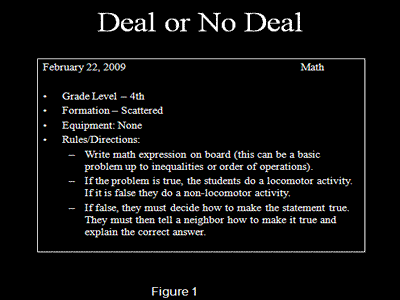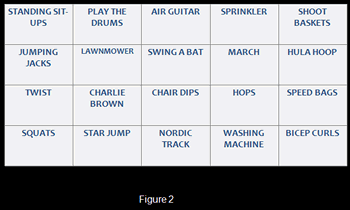|
IMPLEMENTING
CLASSROOM-BASED PHYSICAL ACTIVITY
Written by: Heather
E. Erwin, Ph.D.
 The
National Association for Sport and Physical
Education (NASPE,
2008) recently published a position
statement entitled Comprehensive School
Physical Activity Programs encouraging
school officials to provide physical
activity (PA) to students before, during
and after school hours. In addition,
school wellness policies, which address
PA and nutrition, have been mandated
by the Child Nutrition and WIC Reauthorization
Act of 2004 (PL 108-265, 2004) for all
schools with a federally-funded school
meals program. Classroom-based PA is
one area in which children can accumulate
valuable amounts of PA throughout the
school day. Likewise, PA provides an
alternative context in which teachers
can introduce academic content. The
purposes of this article are: (1) to
summarize literature pertaining to PA
conducted in the classroom; and (2)
to present practical suggestions for
implementing classroom-based PA within
the overall comprehensive school PA
program. The
National Association for Sport and Physical
Education (NASPE,
2008) recently published a position
statement entitled Comprehensive School
Physical Activity Programs encouraging
school officials to provide physical
activity (PA) to students before, during
and after school hours. In addition,
school wellness policies, which address
PA and nutrition, have been mandated
by the Child Nutrition and WIC Reauthorization
Act of 2004 (PL 108-265, 2004) for all
schools with a federally-funded school
meals program. Classroom-based PA is
one area in which children can accumulate
valuable amounts of PA throughout the
school day. Likewise, PA provides an
alternative context in which teachers
can introduce academic content. The
purposes of this article are: (1) to
summarize literature pertaining to PA
conducted in the classroom; and (2)
to present practical suggestions for
implementing classroom-based PA within
the overall comprehensive school PA
program.
It has been
shown that classroom-based PA provides
beneficial amounts of PA for children
(Erwin, Abel,
Beighle, & Beets, 2009; Oliver,
Schofield, & McEvoy, 2006; Stewart,
Dennison, Kohl, & Doyle, 2004)
and that PA can occur in the classroom
without compromising learning (Ahamed,
Macdonald, Reed, Naylor, Liu-Ambrose,
& McKay, 2007; Della Valle, Dunn,
Dunn, Sinatra, & Zenhausern, 1986;
Maeda & Randall, 2003). In
addition, a handful of studies have
revealed a positive relationship with
PA and specific facilitators of learning
such as on-task behavior (Mahar,
Murphy, Rowe, Golden, Shields, &
Raedeke, 2006; Molloy, 1989),
concentration (Lowden,
Powney, Davidson, & James, 2001;
Norlander, Moas & Archer, 2005),
memory (Della
Valle et al., 1986), comprehension
(Ulrich & Swalm, 2007), and specific
reading and math skills (Fredericks,
Kokot, & Krog, 2006). Research
also indicates a trend toward PA and
increased academic achievement in children
(Coe, Pivarnik,
Womack, Reeves, & Malina, 2006;
Sallis, McKenzie, Kolody, Lewis, Marshall
& Rosengard, 1999).
Classroom teachers
have expressed both positive and negative
perceptions of integrating PA during
the day. They understand the importance
of PA for children and appear to be
willing to integrate movement, given
appropriate resources (Parks,
Solmon & Lee, 2007). They
also indicate that it is fun and enjoyable
for the children, and PA is a positive
part of the children’s day (Lowden
et al., 2001). Barriers for teachers
to implement PA experiences for students
include the low priority in many school
districts for PA and physical education,
the high priority for standardized testing,
and the lack of significant infrastructure
(e.g., facilities, equipment) (Dwyer,
Allison, Barrera, Hansen, Goldenberg,
& Boutilier, 2003). As a
result of these barriers, it has been
found that although teachers see the
importance of PA for children, they
are not integrating movement in the
classrooms very often (Parks
et al., 2007).
A variety of
resources exist for implementing classroom-based
PA throughout the school day, including
Active and Healthy SchoolsTM activity
break cards, Promoting Physical
Activity and Health in the Classroom
activity cards, Energizers, and Take
10!®. These resources provide an
excellent starting point for teachers
and are flexible enough to be modified
to meet the needs of specific classrooms.
In general, teachers can utilize these
readily available activities for 5-10
minutes throughout the school day; as
a result, research suggests students
may be more attentive, have higher concentration
levels, and show better on-task behavior
following each PA episode.
Practical strategies
for implementing classroom-based PA
include tying PA to academic content,
preparing a word movement collection,
creating space in the classroom, selecting
the appropriate times to implement classroom-based
PA, and organizing laminated task cards
that are easily accessible.
One place for
teachers to begin when developing activities
tied to academic content is the educational
standards. Creating movement activities
based on a specific academic area may
help students remember the concepts.
One specific example is an activity
called Deal or No Deal. See activity
card for details.
 |
Another
strategy is to create a word movement
collection, in which a variety
of activities that can be performed
in place are typed into a table.
See word movement collection example
for details. These are cut up
and placed in a hat or cup. During
each activity (similar to Deal
or No Deal), the teacher
or students can draw an activity
out of the hat to determine which
movements to perform for each
answer (i.e., true = march in
place, false = star jumps).
|
Creating appropriate space in the classroom
is an approach that can enhance movement
experiences in the classroom. It is
important for the teacher to consider
safety of the students, and moving desks
and tables to specific areas will provide
more open space for students to move
during activity breaks. Figure 3 shows
the activity area/space available in
a traditionally organized classroom.
Figures 4 and 5 show alternative classroom
set-ups to increase the activity area
within the given space.
Additional strategies
for implementing classroom PA include
selecting appropriate times for activity
breaks and organizing laminated activity
cards for easy access. A good rule of
thumb is to allow students to change
activities after 20 minutes; therefore,
a short activity break would be suitable
following a long session in which the
students have been sitting and working
at their desks. Other fitting times
for activity breaks would be first thing
in the morning, after lunch, during
transitions to special classes, and
right before dismissal. It might be
more challenging to offer activity breaks
immediately following recess or an assembly.
Finally, having
access to activity cards will increase
the chances that the teacher will utilize
them. One suggestion is to laminate
them so they will last longer, bind
them on a ring, and hang them on the
wall near the door or chalkboard in
the classroom. The teacher can find
them easily and quickly flip through
the activities to lead the students
in movement when necessary.
It is important
to teach future elementary teachers
the importance of PA in the classroom.
This can be emphasized in their physical
education preparation course during
their teacher training. Valuable activities/assignments
that can be incorporated for those teachers
include ice breakers, active recess,
nutritious school parties, and PA DVDs
assignments.
The ice breakers
assignment will require pre-service
teachers to create and design short
ice breaker, energizer, and relaxation
activities that could be used in their
classrooms upon graduation. The active
recess assignment will prepare teachers
to design recess spaces for maximum
activity. For instance, they will designate
specific areas of the playground for
different types of activities (e.g.,
tag, soccer, jump ropes, walking) and
plan appropriately according to the
equipment available at their school.
The nutritious
school parties assignment will prepare
the future teachers to communicate this
philosophy with parents and brainstorm
healthy food choices for parties as
well as alternatives to food rewards
for students. The PA DVDs contain short
5-10 minute video clips of the elementary
education students performing activity
to music. The hopes are that these pre-service
teachers will utilize the videos in
their classes and be willing to create
more in the future.
In addition
to training pre-service elementary education
teachers, in-services are valuable for
practicing teachers in the field, and
support from physical educators is warranted.
During these sessions, the physical
educators can make classroom teachers
aware of available resources as well
as provide guidance on managing students
in a PA setting. For example, the physical
education teacher may provide sample
classroom activities for the teachers
while demonstrating how to form students
in pairs or teams quickly and efficiently.
Short bouts of instruction time, freezing
students, and equipment dispersal and
retrieval should also be addressed.
In conclusion,
classroom-based PA can be a meaningful
way to increase children’s overall
PA levels and reinforce academic content
in school. Physical education teacher
educators and in-service physical educators
can play important roles in facilitating
the implementation of PA breaks by providing
valuable opportunities for future classroom
teachers to prepare to implement classroom-based
PA and by presenting management strategies
for elementary teachers to follow, respectively.
|



